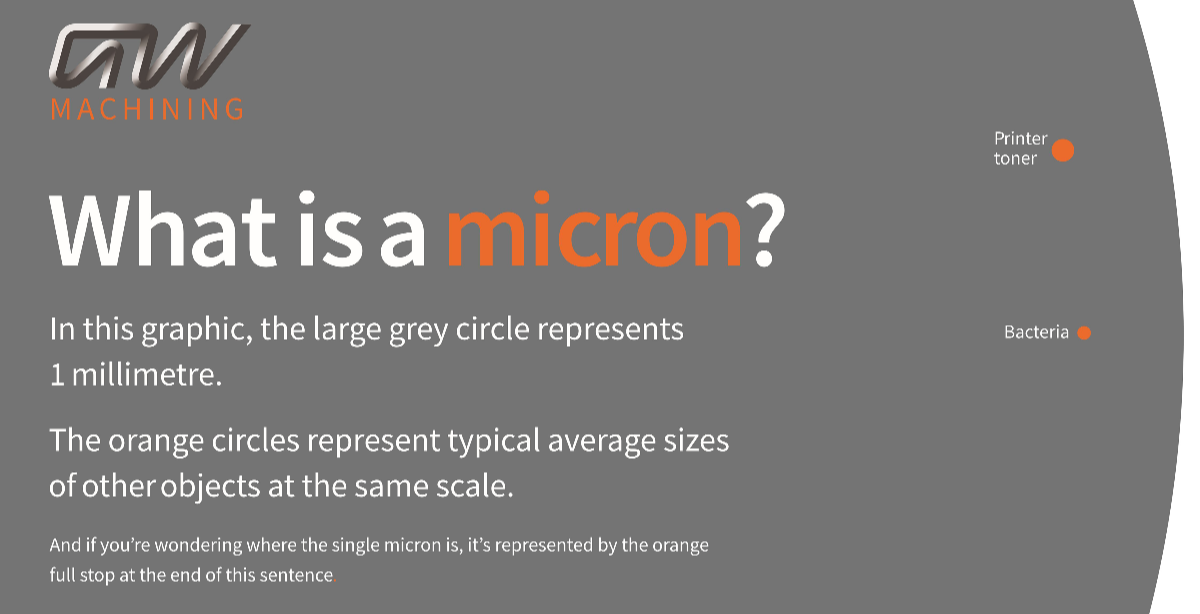In our recent ebook, "The Machining Buyers Guide", we discuss how understanding what a micron is and how it impacts machining decisions is worth some consideration.
What is a micron?
A micron is a unit of measurement that represents a small distance - one thousandth of a millimetre to be exact. In real terms, a micron is approximately 1/70th the thickness of a piece of standard A4 paper, or about the size of a bacteria cell.
Machining parts requires micron-level accuracy to achieve specified tolerances.
Why do we need to specify tolerances on drawings?
While models on a CAD screen use dimensions for parts that are always exact, nothing is ever perfect in reality.
Real world fluctuations in temperature can cause expansion, internal material stresses can relax and cutters can wear over time. Even measurement equipment has accuracy limits. So, if your part drawing specifies you need a dimension to be 100mm, you’re never going to achieve this.
Instead, the important question then becomes how close to 100 mm you’re willing to accept. A relatively small part can change (grow or shrink) by several microns with tiny temperature changes alone. The tighter the dimensional tolerance, the greater the costs incurred.
How much does a micron cost?
In a particularly famous example, a two-micron error on the Hubble telescope mirror resulted in a blurry image and a $1.5 billion Shuttle trip to repair it.
But on a more day-to-day part buying level, microns can still cost large sums for buyers. As well as errors in micron accuracy, over specifying un-needed tolerance on part dimensions can lead to extra costs, something that as a buyer, you’ll be actively trying to avoid.
Understanding exactly what micron-accuracy you actually need is essential to achieve the most cost-effective yet still accurate part.
Over tolerancing on dimensions
The most likely cause of microns costing large sums is the over tolerancing of dimensions on the drawing. While it’s easy to over specify on a CAD drawing, it’s often not needed. But working with your supplier will enable you to specify tolerances that are really needed, as well as choose the best process to machine your part.
There are many manufacturing processes available, each suited to different tasks. Some have low process capability. Others have higher precision, but then they’re either slower or more expensive.
The tolerances specified on your drawing will tell your supplier which processes they need to machine your parts, so it’s important to specify both accurately and realistically.
Additional costs associated with tolerance
The tolerances on your drawing will also tell your supplier how they need to measure the part. These choices will impact hugely on cost. For example, will a steel ruler be precise enough? Or will you require the use of £1 million of CMM (Coordinate Measuring Machine)?
Tolerance specification also has huge implications on the machine’s temperature control, the coolant and even the entire internal volume of a huge factory- again all with associated cost.
There can also be further complications which impact cost and lead times. Not all machining facilities have the capability to manufacture all processes. As a result, you may end up in a situation where your suppliers can meet some requirements, but not all. This can lead to a costly and lengthy subcontract loop.
Conclusion
Microns are a small unit of measurement. But hitting micron-level accuracy can cost vast sums, especially if tolerance is over-specified in the drawing stage for your part. Understanding this, as well as working with your supplier to understand exactly what you need will ensure your part is accurate, yet still cost effective.
Want to know more about buying machined parts? Our Machining Buyer’s Guide is a free, information-packed resource written especially for buyers.


 Get in touch
Get in touch
